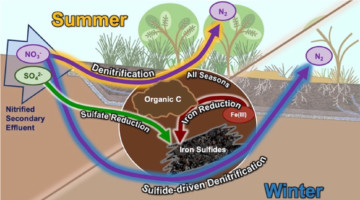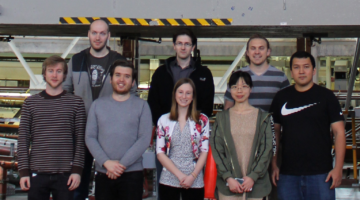A big plus for batteries based on sodium over lithium is that sodium is more earth-abundant, which lowers costs and eases environmental and supply-chain concerns. Research to improve the performance of sodium-ion batteries includes this effort to use copper doping of the cathode to enhance oxygen redox reversibility. Read more »
Antoine Wojdyla Receives Prestigious Five-Year Research Grant
Antoine Wojdyla is one of three scientists at Berkeley Lab selected by the U.S. Department of Energy’s Office of Science to receive funding through the Early Career Research Program (ECRP). His project is titled DREAM beam: Diffraction-limited Radiation Enhancement with Adaptive Mirrors for X-ray coherent beamlines. Read more »
Removing Nitrogen from Wastewater using Horizontal Levees
Treated municipal wastewater often contains nitrogen, which has been linked to algal blooms that can devastate coastal ecosystems. In a recent study, researchers characterized the primary nitrogen-removal pathways in a horizontal levee, an engineered subsurface water-treatment system consisting of a gently sloping strip of land adjacent to storm-control levees. Read more »
Pushing the Boundaries of Moore’s Law: How Can Extreme UV Light Produce Tiny Microchips?
For the past 25 years, scientists and engineers from the Center for X-Ray Optics (CXRO) have worked to develop EUV lithography, a technique that enables microchip circuits and transistors that are tens of thousands of times thinner than a strand of human hair. Patrick Naulleau, a CXRO scientist who helped develop EUV lithography, shares his perspective in this Q&A. Read more »
Paris Gordon, User Services Office Administrator
Paris Gordon’s love of science started at a young age, as did her connection to Berkeley Lab. Throughout her 24 years here, she has built strong relationships with people from all around the world. Find out more about what she does in the User Office. Read more »
Three SCGSR Awardees to Conduct Research at the ALS
The Office of Science Graduate Student Research (SCGSR) program will provide Michelle Devoe (UC Berkeley), Abraham Lewis Levitan (MIT), and Dayne Yoshiki Sasaki (UC Davis) with supplemental awards to conduct research at the ALS in areas that address scientific challenges central to the Office of Science mission. Read more »
Looking Inside a Battery with Infrared Light
Researchers have developed a new infrared methodology with unparalleled spatial and chemical imaging capabilities that helps to characterize processes at the interfaces between electrodes and electrolytes, with an eye toward bringing increased safety, lifetime, and energy density to the next-generation solid-state battery market. Read more »
ALS Doctoral & Postdoctoral Fellowship Applications Open May 6
ALS Doctoral and Postdoctoral Fellowships allow researchers to spend a year in residence at Berkeley Lab working at the frontier of synchrotron radiation research and helping advance state-of-the-art techniques and applications. The next application cycle will be open May 6–June 6, 2022. Read more »
Key to Coral Resilience Is Faster Skeletal Crystallization
In a new study, researchers show that the crystallization rate of coral skeletons differs across species and is correlated with their resilience to ocean acidification. The results have implications for predicting coral reef survival and developing mitigation strategies against having their bony skeletons weakened by ocean acidification. Read more »
Sintu Rongpipi, Scattering Postdoc
Having spent a lot of her PhD studies doing research at the ALS, Sintu Rongpipi knows that synchrotron characterization brings her moments of immense joy. Find out what she’s characterizing now as well as her secret talents. Read more »
- « Previous Page
- 1
- …
- 12
- 13
- 14
- 15
- 16
- …
- 28
- Next Page »









